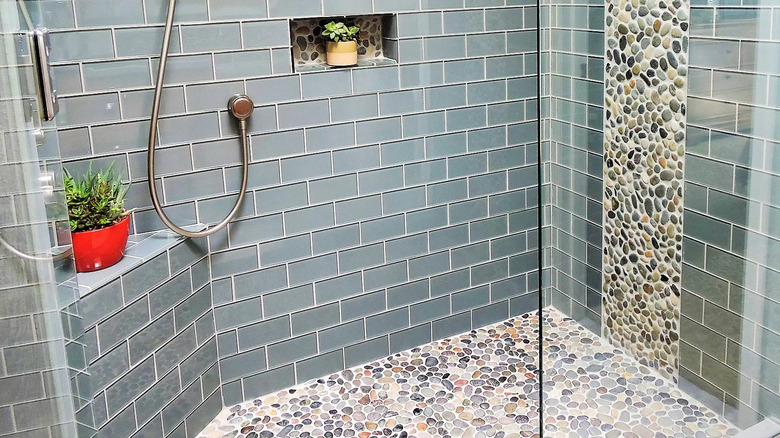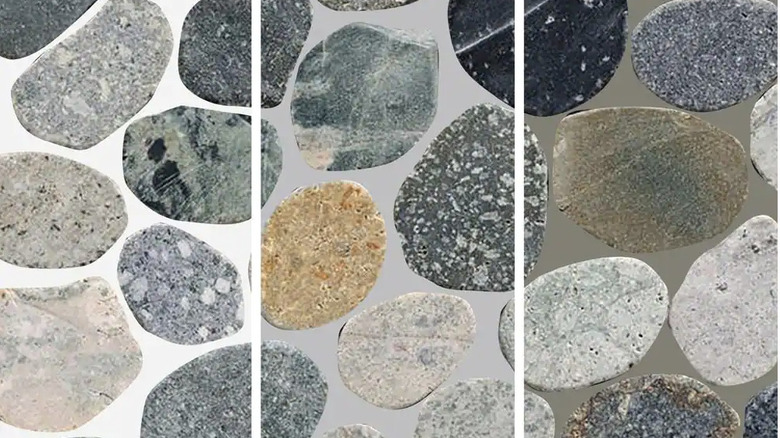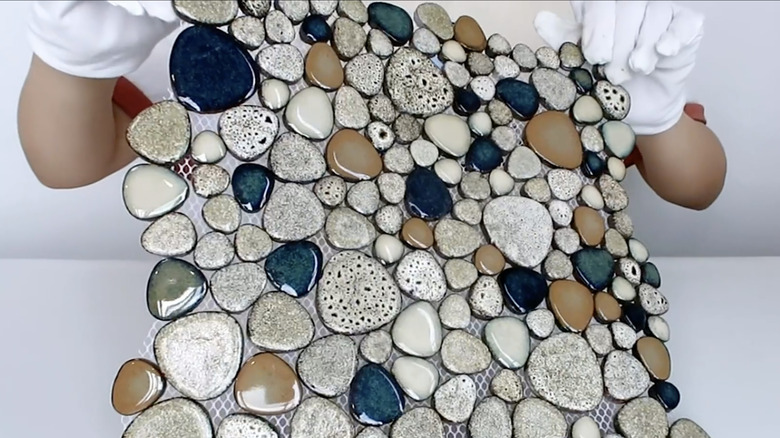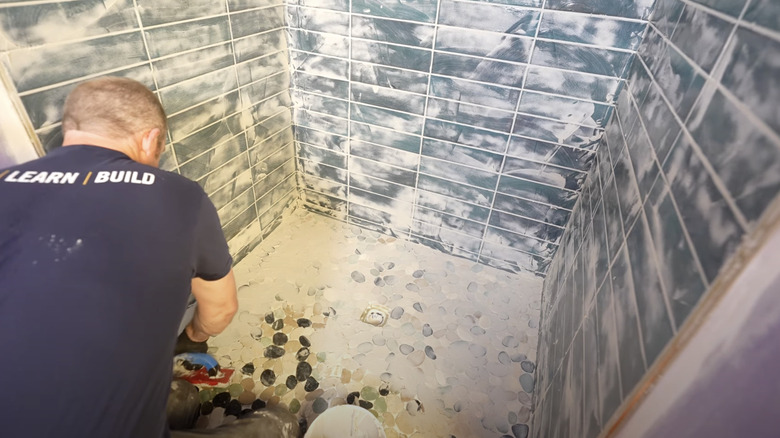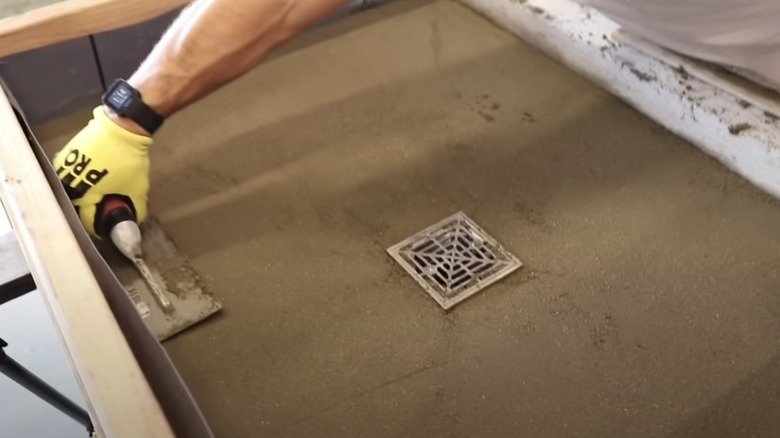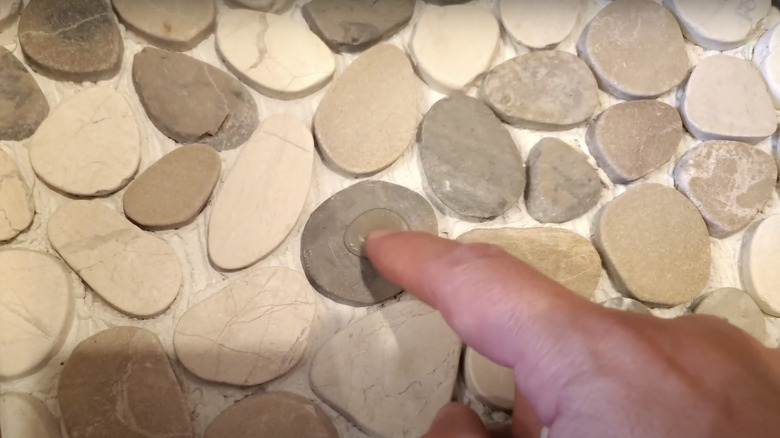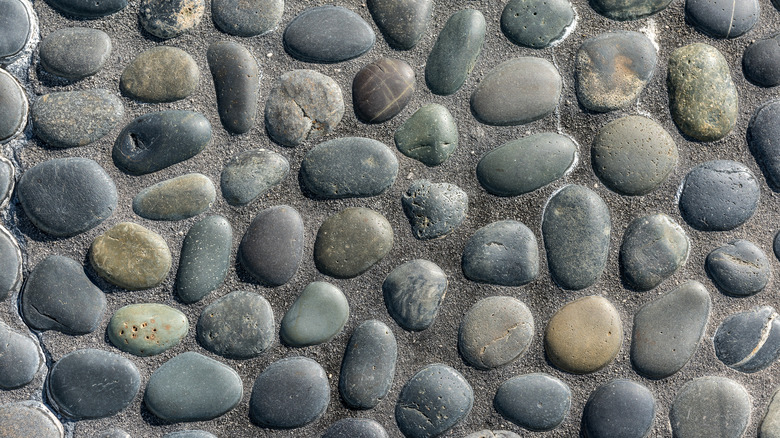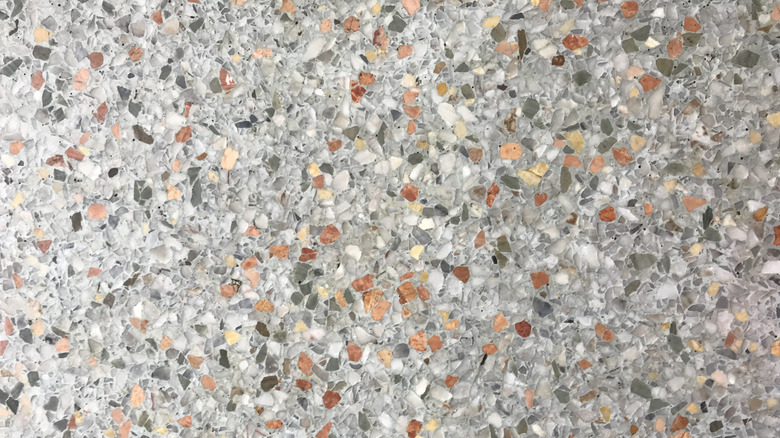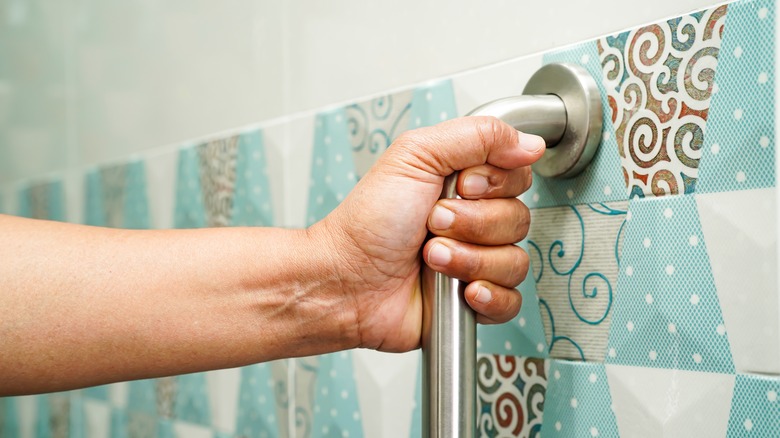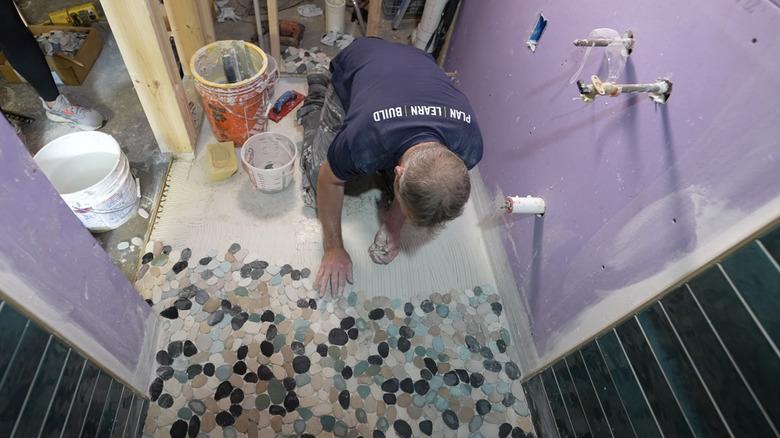Why You Should Think Twice Before Installing Pebble Shower Floors
We may receive a commission on purchases made from links.
Embracing nature in interior design is a trend that never goes out of style. Amateurs and professional designers alike love connecting indoor spaces to the outside world by using natural influences. Pebble floors are a gorgeous concept, bringing the look of river rocks into your home.
Installing this feature in your shower adds a rustic, but still luxurious, touch that is difficult to imitate with classic non-dimensional tiling. The unique flooring may have unmatched beauty, but the non-conforming, bumpy design isn't all rainbows and butterflies. Its complicated form is tricky to install and maintain long-term. The texture isn't ideal for everybody, and there's always the chance of hiring an inexperienced contractor who doesn't know the risk and precautions that come with this flooring.
Keep in mind that showers aren't just for decorative purposes. They should be crafted with functional intent, and sometimes, design choices can impede their practicality. Learn more below about pebble shower floors and why you may want to think twice before making this interior design choice.
There aren't as many design options as there are with other flooring types
Modern-day homes have an abundance of shower floors to choose from, including ceramic, concrete, natural stone, or porcelain materials. Traditional tiles, usually made of ceramic or porcelain, come in vast color, pattern, and shape options, which provide nearly infinite design opportunities. In comparison, pebble floors, which are often made of natural stone, come in repeating patterns with little variation in texture, size, and arrangement.
People who want to customize every last inch of their bathrooms may see this as a problem. However, the floor is still customizable to an extent. Pebble tiles come in various color schemes, ranging from natural neutrals to colorful pinks and blues — though most of these color schemes are muted pastel shades. When browsing pebble tile options, choose between different grout colors to change the look.
Aside from the color, the pebble tiles also vary in shape. Some collections have sharp polygonal appearances, while others have a rounded oval shape. You can find styles that are slightly raised or that are shaved down to create a flatter surface.
The pebble tiles aren't seamless
Pebble flooring may look good from afar in those dreamy Pinterest boards and AI-generated concept art, but the seamless array of pebbles is not so idealistic in real life. Photographs don't always catch the grout lines between pebble tiles, which clearly delineate each sheet. Pebble flooring is produced as foot-by-foot tiles, which lay together like puzzle pieces. The lines between the pieces create a grid-like appearance akin to traditional tiling that many find unappealing. It disrupts the intended natural look of pebble flooring, since the edges are unlikely to match up, leaving distinct lines between each set. The "grid" is even more prevalent when wet because water makes the tiles glisten and grout lines darken.
Luckily, this aesthetic downfall is avoidable if you hire the right contractor. Katie Jones, the interior designer behind Jones Sweet Homes, recommends, "Go with a sliced or flat style pebble for sure. Get an installer who will take the time to place pieces by hand to avoid the grid look." She also encourages people to, "Choose a style with multiple colors of stones." Implementing these tips creates more variation, which helps mask the grid. Ultimately, this fashions a more cohesive and attractive pebble shower floor.
Laying the tiles takes a surplus of sanded grout
Grout is necessary for tiling. If you aren't familiar with the material, it is a concrete aggregate for filling in the lines between tile pieces. No matter how tightly packed and sealed, grout is still a porous material that retains water. Pebble flooring requires a larger amount of grout than more traditional tile floors. This is because grout is required between tiles, where the wall meets the floor, and between pebble pieces. More grout means more volume of porous material that potentially absorbs water and gradually leaks into the foundation below.
Stepping on the grout-encased pebbles daily stresses the surface, just as you would any other material. However, since the pebbles are uneven, your weight is even more likely to nudge the stones aside and create tiny gaps. When these pebbles slightly move out of place, it leaves a vulnerability where water can seep through.
To avoid a water-infused grout disaster, hire a contractor with experience or knowledge in laying river rock-style flooring. Check out your contract and make sure they intend to inspect and seal the subfloor in addition to laying new tile. If it doesn't already have it, the subfloor needs a water-resistant sealant to protect it from potential leaks later on.
The style doesn't drain without extra engineering
The preparation of this floor is almost as important as laying the tiles themselves. Due to the shape, the pebbles can inhibit water flow toward a drain and leave standing water after your shower. There's no way to eliminate this completely, especially if you use raised, natural-form pebbles.
Skilled contractors purposely slope the floor slightly downward toward the drain, ensuring water runs a certain way. They should also sand down the grout near the drain to help direct moisture in the right direction. You don't have to leave everything up to the contractors, and it doesn't hurt to use outside resources. Purchase a dehumidifier and get in the habit of running it after your showers to help lower the moisture content in the air.
In the end, as much as you may love the raised rounded stone look, the impracticality of it might outweigh the aesthetic appeal. Many manufacturers have released pebble tile designs with flattened or "sliced" rocks that lay flat against the grout. The combination of tactics reduces how much water gets trapped in your bathroom, making drainage more effective and mold less likely.
Homes with hard water are not compatible with pebble floors
Your subfloors aren't the only part of your home requiring inspection before installing pebble shower floors. Given this flooring is installed directly under running water, you must ensure your water quality is up to par. Hard water is a common issue in many homes. By definition, this is water that is heavy in minerals, namely calcium and magnesium. These minerals aren't necessarily dangerous, but they do leave build-up on your body, plumbing fixtures, shower walls, and floors after use.
This build-up does not mix well with pebble flooring, which is already tricky to keep clean with softened water. A greasy residue will develop over the pebbles and grout lines, which is a hassle to remove. If you neglect to clean regularly, the residue could become slippery and dangerous for household members, turning your glamorous shower into a liability.
Fortunately, you can reduce hard water in your home with a simple water softener installation. These systems can be costly and require routine upkeep, but are useful beyond just enabling a practical pebble shower flooring installation. The softener appliance makes water from water lines tastier, clearer, and less harsh on all of your plumbing fixtures — not just the floors.
Routine maintenance and deep cleaning are necessary
Even if your home isn't afflicted with hard water, pebble floors need more maintenance than most surfaces. Cleaning a shower is one of the most tedious household chores, which is why there are many cleaning formulas for simplifying the process. While some allow you to just spray and walk away without rinsing, quick solutions like this aren't an option for the bumps and grooves between pebble tiles.
You must spray the uneven surface with a cleanser and thoroughly scrub the pebbles and grout to remove soap scum, hair, mold, and mildew. Rinse after scrubbing to remove any remaining debris and cleaning formula. Leave the shower door or curtain open so the surfaces air out and dry. Keep in mind that pebble floors take more physical force to clean, which ironically, also slowly wears down and diminishes their lifespan. This is time consuming, especially if you have a large walk-in shower, which is common with this type of design.
You can make cleaning easier on yourself by sticking to a schedule. Weekly wipe-downs feel far less time consuming than intense deep cleans. Mold and mildew can quickly spread out of control, especially in tiles, grout, and other porous materials. It may be impossible to remove if debris is too deeply embedded in the crevices between pebble tiles. Keeping the problem at bay before it begins is the best approach.
People with certain conditions or sensory issues may find the texture uncomfortable
Those who live in shared spaces should know that a pebble floor may not suit everyone in a household. One of the most prominent characteristics of pebble flooring is the raised stones that create a bumpy surface underfoot. Some people love this feeling, comparing it to spa-like experiences where you walk on rocks to relieve tension and better physical health. While this may be the case for many, this "therapeutic" experience isn't for everyone.
People who are hypersensitive, such as those with autism, may not enjoy the uneven surface underfoot. Some individuals have foot issues, like plantar fasciitis, where barefoot walking is already painful. Having a previous affliction puts additional stress on their feet when walking on the bumps and dips in pebbles. A pair of shower shoes might solve this problem, but it may be easier to avoid installing the floor altogether. Otherwise, you should consider a floor with a flatter surface, such as "sliced pebbles," where the tops are shaved off to make a more smooth surface.
The smooth pebbles can become a slippery fall hazard
Mold and mildew-encrusted shower floors aren't just gross from an aesthetic standpoint — they pose a health and safety risk, too. This isn't just a fact for pebble flooring. All shower floors should be kept mold-free to keep their surfaces from becoming slippery and teeming with bacteria. Although this is a potential issue for all shower designs, pebble floors are more susceptible due to their texture. They are a prime environment for mold and mildew growth because they're harder to clean and tend to retain water. The variations in shape and color also make mold difficult to spot, and therefore even more dangerous.
Aside from a dedicated cleaning schedule, ensure the pebbles are treated with a non-slip treatment, like Slip Doctors Stone Grip. If you aren't using authentic pebble flooring and opt for a ceramic imitation, you can rely on a rating system known as the Coefficient of friction rating (via Home Depot). This rating system measures the friction of tiles to determine their traction. A rating above 0.5 provides enough natural resistance, but ratings above 0.60 may be safer if your roommates or family members are children, elderly, physically disabled, or simply accident-prone. You can also install shower grab bars for an extra grip when entering and exiting the shower.
Pebble-style is more expensive than porcelain and ceramic
One of the most common misconceptions behind pebble flooring is that it's cheap and easy to DIY. This statement is only true if you're using river rocks foraged from nature and you're skilled enough to create a long-lasting and safe installation. The reality is that, unless you know how to properly set and seal natural river pebbles with grout, the process isn't as affordable or simple as traditional porcelain or ceramic tiling.
Traditional tiles can cost as low as a few dollars per square foot, while pebble floors creep up to the $10 to $20 range. It was previously mentioned how much grout is necessary for this process, meaning you'll also need to invest more in the setting materials. The installation process itself will cost you too, as Home Depot puts the average at about $1,500 for ceramic and porcelain installations, so expect to pay upwards of that amount for pebble tiles, especially if you're covering a larger area.
